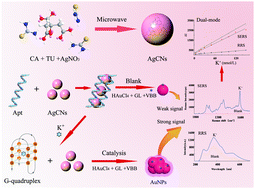Strong catalysis of silver-doped carbon nitride nanoparticles and their application to aptamer SERS and RRS coupled dual-mode detection of ultra-trace K+†
Abstract
A novel nanocatalyst of silver-doped carbon nitride quantum dots (AgCNs) was prepared by a microwave procedure, and characterized by electron microscopy, infrared (IR) spectroscopy, surface-enhanced Raman scattering (SERS), resonance Rayleigh scattering (RRS), fluorescence and absorption techniques. Using the slope procedure to evaluate the nanocatalysis, it was found that AgCNs strongly catalyzed the reduction of HAuCl4 with glucose (GL) to generate gold nanoparticles (AuNPs). The produced AuNPs had strong SERS activity and RRS effect. With a Victoria blue B (VBB) molecular probe, the SERS intensity at 1616 cm−1 increased linearly with the concentration of AgCN nanocatalyst. Similar to the SERS, the RRS intensity at 370 nm also increased linearly. Aptamer (Apt) could inhibit the AgCN catalytic activity. K+ combined with Apt to form stable G-quadruplexes and release AgCNs that enhanced the SERS and RRS signals by resuming the catalytic pathway. Coupling the two scattering techniques of inelastic scattering SERS and elastic scattering RRS, we developed a dual-mode scattering method for label-free Apt detection of 5–150 nmol L−1 K+ with a detection limit of 0.92 nmol L−1. Furthermore, we successfully applied a coupled two mode scattering analysis and improved the SERS precision, and proposed a reasonable AgCN catalytic mechanism.



 Please wait while we load your content...
Please wait while we load your content...